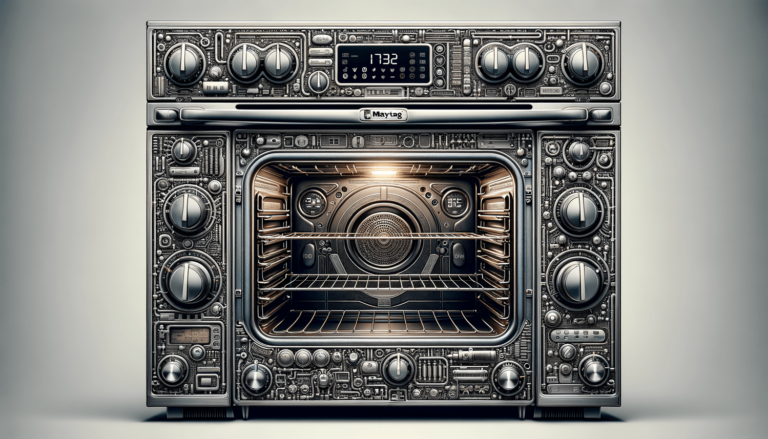

Welcome to our in-depth exploration of Maytag Oven Settings! Getting the perfect results with your baked or roasted goods depends on understanding and properly using the options provided by your appliance. In this blog post, we’ll unpack the diverse range of Maytag Oven Settings, helping you make the most of your home cooking experience and ensuring delicious outcomes every time. Let’s get started!
Maytag offers a range of oven settings designed to cater to your various cooking needs. Below, we’ve comprehensively listed all the settings, modes, and types available.
The Standard Bake setting uses the lower heating element for heat distribution, providing even cooking throughout the oven cavity. This setting is perfect for everyday baking, such as roasting meats or baking cakes, pies, and bread.
Convection Bake uses a fan in the back of the oven to circulate hot air, resulting in faster and more even cooking. This setting is ideal for pastries, cookies, and multiple trays of food since the air circulation reduces the risk of hot spots.
The Broil setting uses the upper heating element, providing intense heat from above to cook food quickly. This mode is perfect for grilling meats and fish or caramelizing the tops of dishes like casseroles and lasagnas.
Convection Roast combines the broil and convection features, using both the top heating element and the convection fan. This results in crispy exteriors while maintaining tender interiors for meats, poultry, and vegetables.
The Keep Warm setting maintains a low temperature inside the oven to keep your cooked food warm without overcooking or drying it out. This is perfect for when you’re waiting for the rest of your meal to finish or for guests to arrive.
The Proof setting creates a warm environment for dough to rise before baking. This setting is ideal for bread, rolls, and other yeast-based recipes.
The Defrost setting allows you to gently thaw frozen items, such as meats, fish, or baked goods. This is a convenient alternative to using a microwave or waiting for items to defrost in the refrigerator.
The Self-Cleaning mode uses high temperatures to burn off oven residue, making it easier to clean. To use this feature, simply follow the manufacturer’s instructions for safety and cleaning guidelines.
Now that you’re familiar with the different Maytag Oven Settings, we’ll provide some supplementary information for you. Utilize these helpful hints from Settings King, your go-to blog for technology settings, to make the most out of your Maytag oven.
Convection Bake is your best friend when it comes to baking multiple dishes simultaneously. Since this setting distributes heat evenly, you can reduce cooking times without sacrificing delicious, evenly cooked results.
Depending on the oven settings you use, optimal rack positioning can vary. For the Standard Bake setting, position your oven rack in the middle of the oven. When using Convection Bake, however, placing your baking sheets on a lower rack ensures better heat distribution.
For an extra-crispy finish on your dishes, use the Broil setting for the last few minutes of cooking. Monitor your food closely, though, as it can quickly overcook or burn due to the intense heat.
When using the Proof setting, coat a large mixing bowl with non-stick spray, place your dough inside, and cover with a damp cloth. The oven’s warm environment shortens the rising process, ensuring evenly risen dough every time.
Don’t forget to utilize the Self-Cleaning mode to maintain a spotless oven with minimal effort. But remember, always adhere to the manufacturer’s safety and cleaning guidelines by removing oven racks and any excess residue before engaging this setting.
As a Maytag oven owner, you’ve made an excellent investment in your home cooking experience. Following the advice from Settings King, a premier blog for technology settings, will help you maximize the oven’s potential. To ensure consistent culinary success, we recommend familiarizing yourself with all the Maytag Oven Settings and using them accordingly.
Proper usage and consistent cleaning of your Maytag oven help to prolong its lifespan. By taking advantage of the Self-Cleaning mode, removing excess residue, and following manufacturer guidelines, you’ll maintain peak performance for years to come.
To become a Maytag Oven Settings pro, follow these top tips from Settings King:
By exploring and utilizing the options provided by Maytag Oven Settings, you’ll not only upgrade your cooking skills but impress your friends and family with mouthwatering dishes.
After reading our Maytag Oven Settings Explained blog post, we understand that you may have additional questions. Below, we’ve compiled some commonly asked questions and provided corresponding answers to help clarify any remaining uncertainties.
Standard Bake uses the lower heating element to provide heat for cooking, while Convection Bake employs a fan to circulate hot air throughout the oven cavity. Convection Bake is known for its even heat distribution and faster cooking times compared to the Standard Bake setting.
The Keep Warm setting is ideal for situations where you need to maintain the temperature of a cooked dish without overcooking or drying it out. Use this setting when waiting for other dishes to finish cooking or when guests haven’t arrived yet.
Optimal oven rack positioning varies based on the oven setting and can greatly impact the outcome of your dishes. Proper positioning ensures even heat distribution, leading to consistent and desirable results for your recipes.
No, you should not use aluminum foil or leave any oven racks inside the oven during the Self-Cleaning mode. Remove all items and follow the manufacturer’s instructions for proper self-cleaning guidelines.
The Defrost setting can be used to gently thaw a variety of items such as meats, fish, and baked goods. This setting allows you to thaw items without the risk of partially cooking or damaging their texture, as sometimes happens with microwave defrosting.